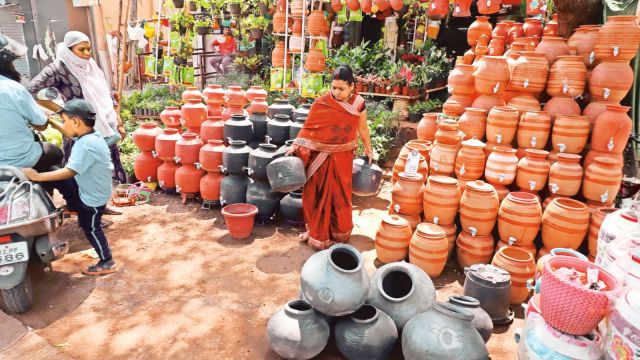Click here to join Express Pune WhatsApp channel and get a curated list of our stories
Pune-based Prayas Energy Group: Analysis of summer weather indicates rising heat levels across Konkan, Western Maharashtra
Researchers say locally validated heat index necessary for early warning systems
 Roadside sale of earthen pots has increased as summer heat increases in the city. (Express Photo By Pavan)
Roadside sale of earthen pots has increased as summer heat increases in the city. (Express Photo By Pavan) An analysis by the Pune-based Prayas Energy Group of changing summer weather patterns indicates a rising trend in heat levels across the Konkan and Western Maharashtra regions— areas that have not traditionally been the focal point of heat stress discussions in Maharashtra.
“The increasing nighttime heat exposure across the state is particularly concerning, as it can exacerbate health risks, especially when coupled with prolonged periods of consecutive hot days and nights,” says Aditya Chunekar, a fellow with the Prayas Energy Group, a non-profit that has been active in furthering public interest in the energy sector through analysis-based policy and regulatory engagement.
Chunekar and other researchers at the Prayas Energy Group point out that to enhance preparedness, a locally validated heat index is necessary for early warning systems. “Additionally, the IMD should make high-resolution weather data publicly accessible in real-time, enabling more accurate analysis and effective heat adaptation strategies,” Chunekar said.
As per data from the Integrated Health Information Platform, from March 1-31 this year, Maharashtra recorded a total of 28 heatstroke cases. Four each are from Gadchiroli and Parbhani, three from Nagpur and Buldhana while two each are from Wardha, Nanded, Nashik, Palghar and Latur while Sangli, Thane, Raigad and Osmanabad districts reported one case each.
State health department officials have set up special emergency treatment units at primary health centres and other health institutions as, according to the experts, this year is shaping up to be another record-breaking summer.
The India Meteorological Department (IMD) issued its first heatwave warning for Mumbai and Konkan as early as February.
Extreme heat poses serious risks to public health, livelihoods, and electricity demand. “While government agencies are implementing targeted interventions, a comprehensive understanding of local weather patterns is essential to making these efforts effective,” researchers at the Prayas Energy Group said.
“One way to assess heat exposure is through a heat index. Summer heat is often linked to temperature alone, but factors like humidity, solar radiation, wind speed and an individual’s ability to adapt play a critical role. Globally, various heat stress indices estimate ‘feels-like’ temperatures, but none have been tested in India. One of the key requirements for developing a reliable local heat index is the availability of highly localised, high-resolution weather data,” Chunekar said.
The IMD currently operates around 60 weather stations in Maharashtra, along with additional automated weather stations. Expanding this network and ensuring public access to real-time or near real-time data would significantly improve heat stress monitoring and enhance early warning systems, experts said.
In the absence of a locally tested heat index, researchers used the Universal Thermal Climate Index (UTCI) to analyse Maharashtra’s summer weather patterns in 2024, the hottest year recorded so far globally.
“Our findings show that Vidarbha and Marathwada were under moderate to severe heat stress as indicated by the maximum UTCI values for most of the summer last year. However, the most significant deviations from long-term trends are in Konkan and Western Maharashtra — regions not traditionally associated with extreme heat. This is critical, as people’s ability to adapt depends on their historical exposure to heat,” Chunekar said.
Nighttime heat stress has also intensified across Maharashtra. Minimum UTCI values in all districts exceeded their 30-year averages, preventing adequate nighttime cooling. Without this relief, the body cannot recover from daytime heat, leading to long-term stress. Adding to the concern, many parts of Maharashtra endured prolonged heat stress, with nearly 15 consecutive hot days in late April last year. In Konkan, extreme conditions persisted for 7–10 consecutive days and nights, significantly straining the body’s ability to adapt.
Click here to join Express Pune WhatsApp channel and get a curated list of our stories








